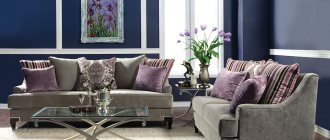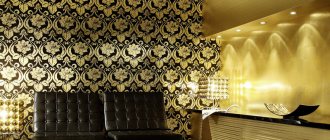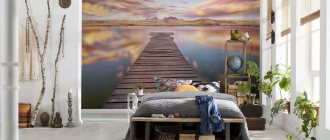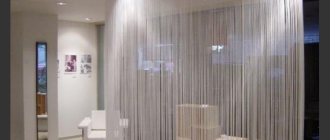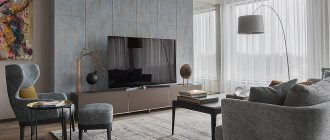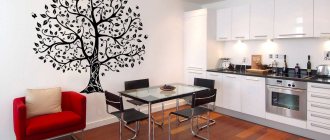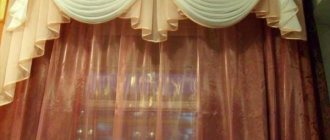Home » Decor » Wallpaper
Living roomDesignKitchen and dining roomWallpaperWall decorationDo it yourselfBedroomInterior styles
Alena Gievskaya
If you want your wallpaper to look extraordinary, try the option with silk-screen printing; you can choose them for any room. Check out all the nuances of selection, gluing and care in this article. Let's take a closer look at each room as an example.
Silk-screen wallpaper
Silk-screen printing is one of the types of vinyl wallpaper that looks rich. The technique for making them has been known since the 18th century; at that time only noble people could afford it. For ordinary people, such material was unavailable due to its high cost.
Wall covering with imitation silk
It consists of two layers: the first is paper or non-woven, the second is vinyl. In their production, the hot stamping method is used:
- the canvas is prepared;
- artificial threads are added to its structure;
- it is applied to a base (paper or non-woven);
- the pattern is pressed through at high temperatures and pressure.
The finished material resembles silk and has a shine that lasts for a long time. The colors come in matte and glossy, their choice depends on the design of the room. Among the drawings, floral patterns are common; abstractions and lines are also in demand.
Using a floral print
In order not to spoil the expensive material and so that it retains its elegant, rich appearance, it is better to entrust the gluing to specialists. Even if you have experience gluing ordinary materials, it is better not to experiment with these.
How to properly glue silk-screen printing
To achieve the desired result, silk-screen wallpaper should be glued only to a perfectly flat, white surface, pre-impregnated with a primer (diluted wallpaper glue can be used as a primer).
The base must be strong, without peeling, moderately absorbent, and dry. Surfaces covered with paint or varnish should be sanded, washed and dried.
Preparation of inventory.
To work you will need the following equipment:
- a bucket or other suitable container for preparing glue;
- scissors and stationery knife;
- brush for applying glue;
- dry cotton rag;
- plumb line or building level;
- large ruler or rule;
- ladder;
- wide spatula for working with corners.
Mixing glue
The process of preparing glue (using the example of Quelyd Special Vinyl):
- Pour room temperature water into a clean container (4-4.5 liters per 300 gram pack);
- While vigorously stirring the water, slowly pour the contents of the package along the edge of the container;
- Maintain a technological break (15 minutes);
- Stir for two minutes - the glue is ready to use.
Applying glue
- Wallpaper is cut into sheets equal to the height of the wall plus 3-5 centimeters at the top and bottom.
- Apply glue to the back side of the canvas, moving from the middle to the edges, using a brush or sponge.
- The pink indicator allows you to control the uniformity of distribution of the adhesive composition.
- Immediately after this, both edges of the wallpaper are folded inward (one edge to the other), which will prevent dust from settling on the glue and ensure the best adhesion.
- After 5-7 minutes (follow the wallpaper manufacturer's recommendations), gluing begins.
Pasting silk screen printing
- 40-45 centimeters are retreated from the corner of the room and, using a plumb line or a building level, a vertical line is drawn, which will serve as the basis for leveling the first canvas.
- Then the upper part of the wallpaper is applied to the wall, aligned along the line, smoothed from top to bottom in a herringbone pattern, expelling air bubbles.
- Excess wallpaper is trimmed with a utility knife, limiting the cuts with a wide metal spatula.
- The following sheets are glued in the same way.
VIDEO REVIEW
Working with corners and joints
Every room has at least four interior corners. Unfortunately, they are not always perfectly even, so experts recommend gluing the corner panels using the cutting method.
To do this, make a small overlap on the adjacent wall (1.5-2 centimeters is usually enough), level the canvas and cut off the excess part of the wallpaper using a spatula in the very corner. The adjacent canvas is trimmed in the same way.
If you need to join two cut edges of wallpaper, just glue the strips overlapping and in one motion cut through the joint with a stationery knife (cutting two layers at the same time). This way you can get a perfectly adjusted connection.
To prevent the joints between the strips from peeling off, it is recommended to carefully coat the edges of the strips with glue and additionally roll the seam area with a special roller.
All windows and doors in the room should be kept closed until the glue has completely dried (up to two days, depending on the humidity and temperature in the room). It is recommended to wash brushes and other tools with warm water immediately after completion of work.
Silk screen wallpaper for the kitchen
Considered suitable for several reasons:
- vinyl is a wear-resistant material, therefore, wiping a stain from the wall will not damage the design in any way;
- moisture resistance - such wallpaper can be washed with a brush using various chemicals;
- service life - frequent renovations in the kitchen are undesirable, so 10-15 years, which are imitation silk, are usually sufficient.
Dining area design option
Although it can be washed, it cannot be cleaned often. Each time the pattern will become duller, the shine will quickly disappear, and, therefore, the rich image will be lost.
To decorate your kitchen, it is better to choose glossy options that withstand washing better. Their shine will remain for years, even if occasionally brushed .
Some people decide to use screen printed vinyl for just one wall in the kitchen. This applies to small rooms; usually the wall chosen is the one near which they sit while eating. If the kitchen is large, divided into zones for cooking and relaxation, then it is better to use such wallpaper in the second.
Properties and advantages of silk-screen printing
Despite its high price, silk vinyl fully justifies it. Thanks to the qualities of vinyl, you can not only professionally decorate your home, but also enjoy working with it. After all, it is not without reason that people have the opinion that if it is necessary to check a person, then you can paste wallpaper with him. So, silk-screen printing has the following properties:
- absence of odor and substances and impurities hazardous to health;
- has a long service life (up to 15 years);
- easy to wash, wet and dry clean, maintaining its original appearance;
- resistant to light, so it does not fade in the sun;
- has a huge number of different variations of designs, ornaments and patterns;
- easily combined in the interior with other types of paper wallpaper and various patterns, if the design idea requires it.
If you have a question about how to properly glue wallpaper, then know that the next stage of the process is working with silk-screen printing. Professionals advise starting gluing the walls from the window opening on the left and then along the entire perimeter of the room. This also applies to silkscreen printing.
Thus, the seams of the wallpaper sheets will not stand out in the sunlight pouring in from the window. Due to this, the papered room looks neat, creating the effect of printed material on the walls.
Return to contents
For the bedroom
This room in the house is usually decorated based on one’s own wishes. No guests or visitors are brought into it, except the owners; this almost never happens. Therefore, when choosing silk-screened wallpaper for this room, you can give free rein to your imagination. The material imitates silk and fabric, which gives the room a special atmosphere.
The thickness and density of the selected wallpaper is not particularly important; aesthetics and beauty play a key role in the design of this part of the house. Silk-screen printing is pleasant to the touch and goes well with satin and silk bed linen. The characteristic shine is noticeable in weak night light.
Stylish decoration for the bedroom
Most of the time is spent choosing colors and shades. If the bed is large and the room is small, a suitable option would be to use silk-screen printing on one wall - behind its back. The rest should be done in similar colors; a variety of colors in this room is not appropriate.
In the bedroom, silk-screen printing in pink shades looks especially gentle on the ceiling; psychologists advise couples who lack sensuality in their relationships to resort to this option.
The main attribute of the bedroom is the bed, so when choosing any parts of the room design, you need to take into account the features of the chosen model. If it has a soft back, it's good, if the wallpaper matches it, it makes a good combination.
Black and white colors in the interior
Why choose and in which rooms to glue
All of the above advantages positively influence the choice of many owners of residential or commercial premises. Besides all this, I would like to mention some additional advantages.
- Thus, liquid silk wallpaper practically does not fade in the sun, coping well with prolonged exposure to direct sunlight.
- In addition, their use will be especially convenient in rooms with non-traditional and individual layouts, such as attics and attics, bay windows, etc.
Correctly applied coating pleases the eye
As for their use in various interiors, then, in general, the application of silk wallpaper is possible in almost any room of the apartment, from the kitchen, living room and bedroom to the children's room, hallway and even the bathroom (in those areas that are not covered by splashes of water). The fact is that this material goes well with any other types of decoration, with furniture, curtains, household items and decors. This creates additional opportunities for creating modern and exclusive interior design.
Good to know! As for manufacturers, one of the most popular on the Russian market is domestic silk wallpaper Silk Plaster. This Russian-made decorative plaster combines decent quality and low price.
Liquid wallpaper varies in texture
As already noted, liquid silk wallpaper has an increased level of environmental safety. This is explained by the use of exclusively natural components in their composition, such as quartz, silk fibers, mineral fillers, as well as various additives that perform a decorative function and determine the texture and color of the material. Therefore, if you decide to apply this finishing composition to the walls of the rooms, then even the simplest and smallest apartment, for example, in a Khrushchev-era building, can be transformed beyond recognition. We’ll talk about exactly how to apply silk wallpaper in the next section.
Related article: Making a mosaic countertop with your own hands: work order
For the living room
Quite a lot of time is usually devoted to decorating the living room, because this room is intended for receiving guests. Many owners, not being able to decorate the entire house or apartment according to their preferences, focus on this particular room.
Silk-screen printing is especially suitable for the living room, giving it an aristocratic look. Among the shades you need to choose neutral colors, bright, catchy ones look vulgar. Some people consider decorating a living room in gray tones gloomy, but in fact, thanks to silk-screen printing, even these inconspicuous shades look festive.
Silkscreen printing is especially suitable for the living room, giving it an aristocratic look
This option is especially suitable for living rooms in a classic style - one of the most common. The room is decorated in subdued colors; only one or several walls may contain imitation gold or silver, which looks especially rich.
Preparing walls for gluing
Silk vinyl is glued exclusively to smooth walls. If we are talking about previously leveled wall blocks, then you can start gluing silkscreen wallpaper without preliminary preparation of the walls. However, if they require elaboration, then you will need the following equipment:
- putty for walls (starting and finishing);
- spatulas;
- sandpaper;
- primer.
The wall is completely freed from old wallpaper, dirt, mold and dust. All surface irregularities are treated with starting putty. Using a spatula, smooth out all the imperfections in the walls with neat strokes in a 3 mm layer. The result is secured with the final putty, which is applied in the same way as the starting putty. The sealed walls dry for 24 hours and are then sanded with sandpaper. The primer layer is applied at the end of the sanding process. Such manipulations will improve the adhesion of silk-screen printing to the walls.
It is very important to work out all the unevenness on the surface of the walls, since unputtyed areas will stand out strongly through the wallpaper.
Features of gluing
It was mentioned above about the need for careful preparation before gluing silk-screen printing on paper.
Advice To avoid bubbles and other problems with the walls after gluing, the walls should always be prepared, it just takes less time before applying the vinyl base.
Ideal texture and color of wallpaper for high-tech style
The basic rule is that the wall must be clean, even if there is no need for primer or putty, dirt must be removed . The gluing itself is carried out according to the usual rules, the main of which is the elimination of drafts in the room. To work you will need the following tools:
- rolls;
- glue;
- putty knife;
- stationery knife;
- roller
The choice of glue is important; you need to buy those options that are designed specifically for wallpaper with silk-screen printing. They are usually heavier, requiring the adhesive to have strong strength due to the weight . In some stores, such glue is designated as a product for “heavy wallpaper.”
Classic style in light colors
Pasting occurs in several stages:
- apply the roll to the wall;
- cut off the required length, leaving 2 cm at the top and bottom for reserve;
- We use the first measured piece as a template, cutting all the rest to its size;
- We start gluing from the door;
- apply glue to the first piece, paying special attention to the corners and edges;
- if the wallpaper has a paper base, treat the wall with glue;
- glue the rolls one by one, joining them to each other;
- align the rolls with a roller;
- The remaining glue that appears at the joints is immediately removed with a spatula.
Difficulties when hanging wallpaper with silk-screen printing may arise at the corners. This material cannot be layered on top of each other; it simply will not stick. Therefore, you have to carefully measure the pieces, try to fit them together correctly, and cut off everything unnecessary in time with a stationery knife.
Original design
Such wallpaper dries quickly, there is no specific smell characteristic of cheaper material. To ensure normal drying, it is necessary to eliminate drafts for a day after gluing.
We dilute wallpaper glue
So what do I have? There is silk-screen wallpaper - 8 rolls. For one wall, one pack of wallpaper glue is enough - I bought KMC glue. The glue was diluted with warm water in advance and left to swell for a day. WHAT is written on the packaging is complete nonsense, or the manufacturer does not follow the glue manufacturing technology.
For example, I diluted the glue as it was written in the instructions, and I got thin water, not even the consistency of liquid jelly, but even thinner.
CMC is an adhesive made from high-quality cotton cellulose and intended for gluing all types of paper-based wallpaper. The sodium salt of carboxymethylcellulose, on the basis of which CMC glue , is an environmentally friendly product with excellent solubility.
KMC adhesive is universal and is intended for gluing washable and non-washable wallpaper on paper, vinyl, fabric and non-woven bases on concrete, plastered, stone, wood and other non-metallic surfaces.
CMC glue is a white or creamy powdery material with a fine-grained or fibrous structure. Fiber structure adhesive is used for gluing only thick wallpaper.
The main difference between light and heavier wallpaper adhesives is the concentration of carboxymethylcellulose: the higher it is, the greater the viscosity of such adhesive.
It’s good that I diluted a small portion of glue for testing. But even in such a liquid state, the glue held lumps for almost a day.
Therefore, I poured it out and diluted it in my own way - I added 1.5 liters of warm 30 0 C water to a pack of glue (although it says 4-6 liters).
The glue stood in the bucket for a day, and then I added another liter or a liter and a half of warm water. Now we have what we need.
Preparing the work site
I freed up space in the hallway to accommodate the roll, washed and dried the floors, and while they were drying (which took 10-15 minutes), I cut 4 strips of wallpaper at once.
This is just one 10.5-meter roll. There are 40-50 centimeters left from the roll, and the wallpaper itself is seamless, that is, there is no need to combine the pattern.
I prepared scissors, a sharp knife, a brush and several dry rags. Scissors - to cut holes for sockets and switches, a knife - to evenly cut a strip of wallpaper to size.
How do I do this? I fold the strip along the marked area, align both edges of the strip (this alignment will result in an equal transverse line), firmly press the wallpaper along the fold and level the fold.
Then all that remains is to run the knife along the fold, and you will get an even, not torn cut.
Then (the walls are smooth, there was no need to putty) I coat one strip of wallpaper with glue, fold it in half so that it does not dry out while it is soaked, and at this time I coat part of the wall with glue under one strip of wallpaper.
Glue and immediately level
The next step is actually gluing the wallpaper . Here, I think, everyone knows how and what needs to be done. I have plenty of experience in this matter, and I always glue wallpaper alone, even on the ceiling. So, I use a roll of wallpaper soaked in glue as a plumb line, so as not to determine the verticality of the first strip with a plumb line. It is visible to the naked eye whether the strip hangs evenly or skewed.
Now, after the strip is applied, but not glued, you need to press it in the middle and center. From this point I move my hand up and down along the central vertical axis of the strip. Next I level it - this should be done from the center to the edges with a dry cloth, roller or wide soft brush.
I did this with a simple piece of fabric. By the time I reach the end of the strip, small air bubbles may appear at first - I remove them too. In general, the process of leveling the wallpaper takes 10-15 minutes. Why so long?
Some tips
I’d rather stretch the strip as much as possible now than to pierce air bubbles on the dried wallpaper later. We work on the same principle for the next roll, and if you glued the first strip evenly, then there will be no problems with the verticality of the remaining strips.
Rules of care
Silk-screen printing is definitely not suitable for the rooms of small children, as well as for kitchens and hallways of families with them. A child will not appreciate all the luxury and attractive appearance of the wall, so he will definitely leave a mark on it.
Glues silk-screen printing in apartments and houses with small children, or on the ceiling. This design will be original, while at the same time protected from the hands of a child.
All types of wallpaper with silk-screen printing require regular cleaning, this allows you to maintain their shine and original sophistication. The most suitable are gel-like compositions, mainly used for washing dishes. With their help, it is possible to quickly eliminate traces of greasy fingers, children's pranks, and other stains.
Wallpaper with silk-screen printing tends to collect dust; to remove it, you need to use a vacuum cleaner. Medium power mode is suitable. You can also use washing vacuum cleaners, but abrasive substances are contraindicated.
Advice: The easiest way to remove a greasy stain is immediately after applying it. To do this, blot it with a napkin, then treat the area with steam. If you don’t have an appropriate vacuum cleaner, you can simply iron it with an iron.
VIDEO: Elegant silk-screen printing in the interior
Silkscreen wallpaper
Amazing elegance in every room
Silk quality sign on the walls
Silkscreen wallpaper is known for its high price compared to other types of wallpaper. This is explained by the fact that they are produced by an expensive method of applying a design by hot stamping onto paper. It is the pressed vinyl on the top layer of wallpaper paper that creates the effect of applied silk. However, some manufacturers skimp on production processes and apply the top coating in a crude and crude manner, due to which the latter loses its elasticity. Such low-quality products will not be well moistened when glued to the walls.
If you glue wallpaper with vinyl silk-screen printing made in bad faith, then when the glue is applied, their edges will turn out, preventing good adhesion to the walls.
The procedure for gluing wallpaper on a vertical surface.
If you glue silk-screen printing with a high-quality top layer, then both it and the paper base of the wallpaper will exhibit their adhesive properties equally well.
As mentioned above, silk-screen wallpaper is classified as vinyl wallpaper, which is based on vinyl paper. During the production process, it is painted, heated and goes through the embossing stage. Due to this, the resulting wallpaper paper is extremely thin, but very durable. However, even thin silk vinyl wallpapers are available in different vinyl thicknesses.
Silk liquid wallpaper: characteristics
Being an analogue of decorative plaster, this material is quite versatile. Its use is possible both in residential and commercial, administrative and other public premises. The rapid growth of their popularity in recent years can be explained not only by their low price, but also by a fairly large list of positive characteristics.
Blends perfectly with the rest of the interior
So, the advantages of this interior decoration option include:
- They increase the level of sound insulation in the room, helping in the presence of noisy neighbors. Improves thermal insulation.
- Hides minor damage to the wall: chips, unevenness, etc.
- They are not harmful to human health and are environmentally friendly and antistatic.
- Creating a completely smooth surface, they have no seams, unlike traditional canvases.
- They are distinguished by their high maintainability, as well as the possibility of use in rooms with high levels of moisture (kitchen, bathroom, etc.). However, in such cases it is recommended to treat them with special varnishes.
- Suitable for application not only on walls, but also on other surfaces in the room: niches, ledges, arches, etc.
Related article: Decorating a room in summer
Composition and features of liquid wallpaper
The dry mixture is packaged in 1 kg bags
They are made on the basis of cellulose flakes (paper), glue and various fillers (flocks): cotton, polyester or silk fibers, as well as glitter, which gives liquid silk a shimmering effect.
The particle size varies - the larger the fibers and flakes, the more impressive and prominent the decor looks.
Liquid wallpaper is used exclusively for interior decoration. They are applied to the ceiling or walls. To create an original interior, you can combine plaster with other materials, such as decorative stone.
The advantages of silk plaster include:
- Easy to apply. The job requires special skills or special equipment.
- Possibility of processing any surfaces. The solution applies evenly and firmly to various materials: wood, concrete, drywall and others.
- Fire safety and non-toxic. The substances included in the mixture are not flammable. The components do not emit harmful fumes, so liquid wallpaper can be used to decorate a nursery.
- Maintainability. If a section of the wall is dirty or scratched, peel off the coating from the problem area and apply a new portion of the solution - after hardening, the restored part will not stand out.
- No seams or joints.
- Versatility and attractive appearance. Liquid wallpaper of this type looks impressive in rooms decorated in any style.
- Plastic. After drying, the high-quality composition forms a soft and elastic coating that is resistant to cracking and shedding.
Expert opinion
Alexander Guryanov
Plasterer and decorator
Important! This type of coating does not tolerate contact with water well, so it cannot be used for finishing rooms with high humidity. In addition, due to the property of liquid wallpaper to absorb odors, it is not recommended to cover kitchen walls with it.
